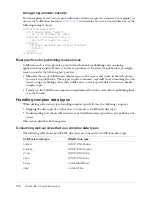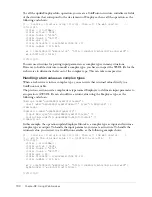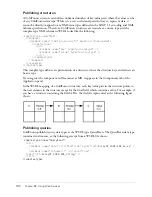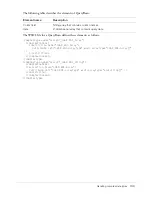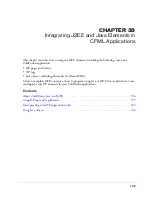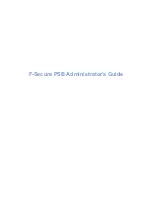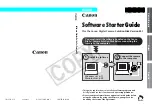
720
Chapter 32: Using Web Services
The following example shows a ColdFusion component that takes a query as input and echoes
the query back to the caller:
<cfcomponent>
<cffunction name='echoQuery' returnType='query' access='remote'>
<cfargument name='input' type='query'>
<cfreturn #arguments.input#>
</cffunction>
</cfcomponent>
If you add this web service in Dreamweaver MX, you see a description of it in the Components
tab of the Application panel.
Note:
This figure assumes that you create a web component named echotypes.cfc that contains the
echoQuery function definition shown above, and that you write the echotypes.cfc file to your web root
directory.
In the WSDL file for the echotypes.cfc component, you see the following definitions that specify
the type of the function’s input and output as QueryBean:
<wsdl:message name="echoQueryRequest">
<wsdl:part name="input" type="tns1:QueryBean"/>
</wsdl:message>
<wsdl:message name="echoQueryResponse">
<wsdl:part name="return" type="tns1:QueryBean"/>
</wsdl:message>
Since ColdFusion automatically handles mappings to ColdFusion data types, you can call this
web service as the following example shows:
<head>
<title>Passing queries to web services</title>
</head>
<body>
<cfquery name="GetEmployees" datasource="CompanyInfo">
SELECT FirstName, LastName, Salary
FROM Employee
</cfquery>
<cfinvoke
webservice = "http://localhost/echotypes.cfc?wsdl"
method = "echoQuery"
input="#GetEmployees#"
returnVariable = "returnedQuery">
<cfoutput>
Is returned result a query? #isQuery(returnedQuery)# <br><br>
</cfoutput>
<cfoutput query="returnedQuery">
#FirstName#
#LastName#
#Salary#<br>
</cfoutput>
</body>
Summary of Contents for ColdFusion MX
Page 1: ...Developing ColdFusion MX Applications...
Page 22: ...22 Contents...
Page 38: ......
Page 52: ...52 Chapter 2 Elements of CFML...
Page 162: ......
Page 218: ...218 Chapter 10 Writing and Calling User Defined Functions...
Page 250: ...250 Chapter 11 Building and Using ColdFusion Components...
Page 264: ...264 Chapter 12 Building Custom CFXAPI Tags...
Page 266: ......
Page 314: ...314 Chapter 14 Handling Errors...
Page 344: ...344 Chapter 15 Using Persistent Data and Locking...
Page 349: ...About user security 349...
Page 357: ...Security scenarios 357...
Page 370: ...370 Chapter 16 Securing Applications...
Page 388: ...388 Chapter 17 Developing Globalized Applications...
Page 408: ...408 Chapter 18 Debugging and Troubleshooting Applications...
Page 410: ......
Page 426: ...426 Chapter 19 Introduction to Databases and SQL...
Page 476: ...476 Chapter 22 Using Query of Queries...
Page 534: ...534 Chapter 24 Building a Search Interface...
Page 556: ...556 Chapter 25 Using Verity Search Expressions...
Page 558: ......
Page 582: ...582 Chapter 26 Retrieving and Formatting Data...
Page 668: ......
Page 734: ...734 Chapter 32 Using Web Services...
Page 760: ...760 Chapter 33 Integrating J2EE and Java Elements in CFML Applications...
Page 786: ...786 Chapter 34 Integrating COM and CORBA Objects in CFML Applications...
Page 788: ......























